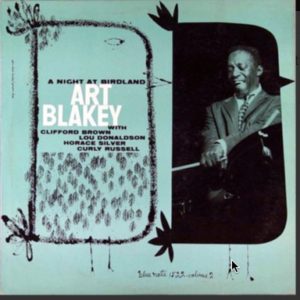Originals vs. Reissues, Another Point of View
 Today we have a guest column by one of our loyal readers. I’ve been corresponding with Daryl Parks periodically for years and am pleased that we are finally able to provide him with a forum for his ideas. This one, we hope, should provoke some thoughts and discussion
Today we have a guest column by one of our loyal readers. I’ve been corresponding with Daryl Parks periodically for years and am pleased that we are finally able to provide him with a forum for his ideas. This one, we hope, should provoke some thoughts and discussion
By Daryl Parks
Discogs currently features an original Blue Note, first press, mono, deep groove copy of the Art Blakey A Night at Birdland Vol2 (VG+/VG+) for $500. Discogs also offers a (NM) 1985 Direct Metal Master, (DMM) French, “Cadre Rouge Audiophile” version, on scrawny vinyl, of the LP for $20 + postage. I own the original Blue Note (VG++) and the DMM re-issue (NM). Prepare for heresy: I prefer the sound of the inexpensive, DMM, anorexic-vinyl re-issue. I’m not sure how to make sense of that.
Multiple variables are at work in this discussion, of course:
1) We collect objects;
2) We collect the sounds of our objects.
It is likely useful to distinguish those two things when we discuss collecting, at least as I try to come to sense with the six crates of records that I allow myself to keep, holy grails and reissues among them.
I love to sort the records as objects. It may be like those Zen sand gardens in which the repetition of rearranging and studying the objects brings joy; I don’t know. I also find pleasure in the idea of owning first press holy grails, showing them to my pals or envisioning my children selling them for prices above what I paid, as I’m lowered into the soil with Dizzy’s Swing Low, Sweet Cadillac playing in the background.
I find the DMM re-issue sound to be superior—more crisp, more separated, and more emotional for me as a listener. The Blue Note original is stellar, yet doesn’t quite match the DMM sound on that LP, to me.
Perhaps my educator-budget components are to blame: Rotel RA 812 amp, Dual 5000 turntable (w/Shure VST-V), and “large” original (rebuilt) Advent speakers, which are altogether uber-sweet, yet may hide the “real” playback sounds evoked by your tubed system that cost more than my house (he said, enviously). I’m also fearful that our 50-80 year-old ears are lying to us about all of our component purchases and playback!
I value your feedback on the major variables at work in this post:
1) If we tease out objects from the sound of objects is it possible that re-issues sound better than originals?
2) Can you listen to your DMM LP’s and give us feedback on whether that re-mastering approach may actually provide a better sound overall?
3) Might these scrawny reissues I praise diminish in quality so quickly that I will bemoan this post for the remainder of my days? Is this really a post of long-term vs. short-term audio quality?
I appreciate your replies as I try to make sense of my love of Blue Note records and DMM reissues.

If you collect records but never play the records, then sound quality means very little–right?
Looking at the covers, checking off the boxes of the have and have not become the sole reason for the hunt. But if you are buying the original pressing of your favorite record (to hear a better quality recording) and find that the reissue sound better than the $400 first pressing you paid for—you learn a valuable lesson… The man at the pressing plant determines the quality of what you buy. Were the presses hot that day when your record was made? Did you get the first records off the press, (in the morning) or the middle or the end of the day’s run? Was the plastic mixed correctly? Was he/she having a bad day, and the attention to quality lacking? Record quality is determined based on the professionalism of the company’s standards and the press operated of that day… And plants varied greatly in those days as those who run the presses.
You can have a $10,000 system or more, but if the record was pressed badly that day—what is it really worth (as a collector who doesn’t play them)–its not really important nor an issue.
Paying for better needle or amp will not improve the sound quality of a badly pressed record. Some of the best looking records–VG+ or M can sound very badly at times.
I have own 1950’s and 60’s Fender’s telecasters and stratocaster’s and some of the early 70’s CBS models sounded better. This is subjective and is determine by the person who wants the items and those who want to play it–right? So, I would say, if it works for you–fine.
In truth, if quality of sound is what you are seeking, you better play it first before you buy, because no one really knows what you are going to get until you put it on… Some first pressing sound wonderful and others sounded badly…
If you are a true collector, and not so interested in how the record really sounds, then this works too. Everyone is happy and the end of the day…
Are the Blue Note DMM’s from 84/85 are sourced from analog or digital?